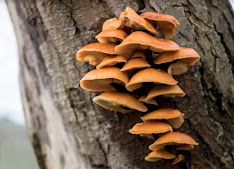For centuries, mushrooms have piqued curiosity, inspired lore, and added vibrant color to our hiking experiences.
You may have heard of plentiful fungi in the old growth forests of the Pacific Northwest or deep in the mitten of Michigan; however, our region in the Susquehanna Greenway—with its abundance of damp, shaded forests—is another ideal location where fungi show their colorful caps.
Although we are between prime times for mushrooms along the Greenway, winter hikers can still enjoy the sight of a showy mushroom or “toadstool” on their outdoor adventures this season.
One such winter curiosity is the Velvet Foot, which only spawns from late fall to early spring, making this a perfect time to get outside and search for this common and unique species of fungi.
Here are some handy tools and information to have in your back pocket for winter mushrooming in the Susquehanna Greenway.
What are mushrooms and why are they important?
Mushrooms or “toadstools” are the fruiting bodies of a fungus. Their umbrella-like structures are often seen poking out of the ground, from a fallen tree, or another of their food-sources.
In a sense, the mushroom is just the tip of the iceberg, as most of the organism lives under the surface decomposing dead plant material. Fungi, like the Velvet Foot, act as nature’s garbage disposal and if it were not for them, we would be buried under a heap of dead trees!
What to look for on your next outing
The world of ‘mushrooming’ is immense. In North America alone, there are an estimated 11,000 named species of mushrooms, outnumbering known birds (~1000 species) and mammals (~500 mammals).
Sifting through these numerous species may seem like a monumental task, but with some keen investigating even the most novice mushroom hunter can uncover this forest floor dweller.
Be a detective: Most mushrooms are going to be found low in the forest near some form of decaying matter.
Start by looking around the base of vegetation. Look for downed logs, brush piles, and tipped over trees. Some mushrooms only grow on certain types of trees, so identifying the trees may increase your chances of locating the mushroom.
Once you locate a species: Start an investigation and ask yourself as many questions as you can. With over 11,000 species, there are a lot of possibilities. Note where it is growing, and what it is growing on. Is it a solitary mushroom, or are there several growing in a cluster? What color is it? Does it grow in shelves on a standing tree or does is have a stem?
Look for details: Most mushrooms feature a top side or “cap,” an underside or “gills,” and a stem. What are the colors of these components; are they different? Remember, your sense of touch can also be used to gather details, as well as your sense of sight (Don’t worry! – There is no danger of being poisoned by touching a fungus).
Take a spore print: All mushrooms make colored spores. To take a spore print, remove the cap, place it gill side down on a sheet of white paper, cover with a bowl or cup, and wait for several hours. Remove the mushroom to see the spore print. You should see the colored spores create an image that mirrors the mushroom’s gills. This trick can be both fascinating and a beautiful form of art, and it is a great activity to do with kids.
Get a guidebook: Bill Russell’s Field Guide to Wild Mushrooms of Pennsylvania and the Mid-Atlantic is a concise field guide that won’t weigh you down on your hike. You can also do your research online, but make sure you get information from reliable sources.
Meet the Velvet Foot Mushroom
If you are hiking through Pennsylvania’s forests from fall to spring, you might stumble upon the Velvet Foot’s beautiful sticky orange to yellow caps growing on dead or downed wood.
These mushrooms need liquid water to grow and cannot fruit when temperatures are well below freezing. So, keep your eye out for it on warmer winter days or around the mild, mid-winter thaw.
True to its name, Velvet Foot has a signature brown to blackish velvety stem that will give you something fun to feel while out hiking along the Greenway.
If you choose to take a spore print, black paper is recommended, as this mushroom will produce a white spore print.
Fun Fact: In 1993, this mushroom was sent to space aboard the Space Shuttle Columbia! Without gravity, Velvet Foot grew at all angles, proving mushrooms use gravity to orient their gills to face the ground. How cool is that?
This winter, take a walk through your favorite hardwood forest. While few things will be actively growing, you just might spot the Velvet Foot Mushroom eating away at a dead stump or log.
When you do find a cluster of these mushrooms, take a minute to appreciate the important work that fungi do for Pennsylvania’s forests. They are some of the most ecologically important and strikingly beautiful organisms we have in our world.
[Visit the Susquehanna Greenway Partnership website to learn more about the Greenway.]
[Caution: This species profile is intended to aid in identification for the appreciation of its aesthetic and ecological qualities of this mushroom. It should not be used to aid in identification for consumption as consuming wild mushrooms and other edibles should only be conducted by experts.]
Andrew Bechdel is the STEP AmeriCorps Susquehanna Greenway & Trails Assistant for the Susquehanna Greenway Partnership. His work is focused on working within the trails and communities of our vibrant and connected Susquehanna Greenway, so that people like you can enjoy opportunities to engage with the outdoors. Andrew can be reached at abechdel@susquehannagreenway.org.
Related Article:
-- Feature - Experiencing Winter On The Susquehanna Greenway
[Posted: February 22, 2022] PA Environment Digest


No comments :
Post a Comment